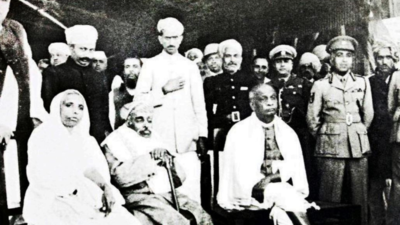Sardar Patel’s 2 Years Of Negotiations With Rajputana Princely States Paid Off | Jaipur News

JAIPUR: Most of the erstwhile Rajputana princely states were at their wit’s end to prevent the merger of their units into the Union of India fearing the compromise of their power and privileges.
It took almost two years of constant negotiations with Iron Man of India, Sardar Vallabhbhai Patel for these princely states to merge into India.
The book ‘History of Rajasthan’s Freedom Struggle’ by Gopinath Sharma, that is based on documents preserved at Rajasthan State Archives Bikaner (RSAB), states that the dewans of princely states of Jaipur, Jodhpur, Bikaner, Kota and Alwar gathered in Kota for formation of a ‘Rajputana Union’ or Naresh Mandal in July 1946.
“They even formed a committee to expedite the process but smaller states like Dungarpur, Jhalawar, Shahpura and Banswara, fearing their interests would be compromised, pulled out,” reads an excerpt from the book.
The royals resisted the initial offer of joining independent India.
“The central government didn’t give up on the merger of the princely states under Patel’s leadership and used the combination of diplomacy and power,” says Mahendra Khadgawat, RSAB director.
Bharatpur was in the eye of the storm as there were a series of communal clashes. Also, there were rumours of links with Mahatma Gandhi’s assassination.
“The documents state that Prime Minister Pandit Jawaharlal Nehru wrote to Patel on January 28, 1948, expressing concern over arms training being given to RSS workers in Bharatpur. The then ruler of Bharatpur, Brijendra Singh was summoned to Delhi on February 10, 1948 by the secretary of the ministry of state, headed by Patel. Singh was asked to hand over Bharatpur’s administration to the Centre as he was unable to control communal riots, maintain discipline in the armed forces and not being able to provide security to railway lines passing through the state,” says Khadgawat.
Finally, consistent efforts paid off. The Union ministry for states managed to form a union called ‘Matsya’ that included the princely states of Bharatpur, Dolpur, Karauli and Alwar.
“The rulers agreed that if needed they will either be merged with Rajasthan or Madhya Pradesh as they are financially not well off,” says Khadgawat.
The situation in Rajputana forced the erstwhile Kota, Jhalawar and Dungarpur rulers to propose a union of them along with Banswara, Dungarpur, Bundi, Pratapgarh, Tonk, Shahpura and Kishangarh in March, 1948.
Later, Udaipur also decided to merge with independent India.
“The final task was to integrate big states like Jaipur, Jodhpur, Jaisalmer and Bikaner which eventually happened with several rounds of discussions. Sardar Vallabhbhai Patel announced the creation of Rajasthan on March 30, 1949, with Jaipur as its capital,” concludes Khadgawat.
FacebookTwitterInstagramKOO APPYOUTUBE




